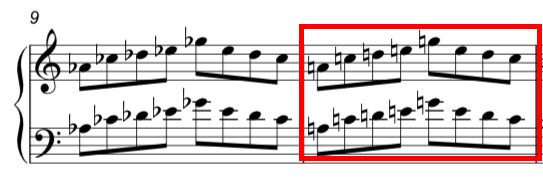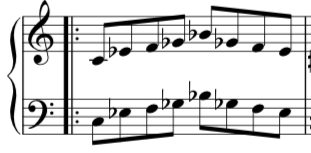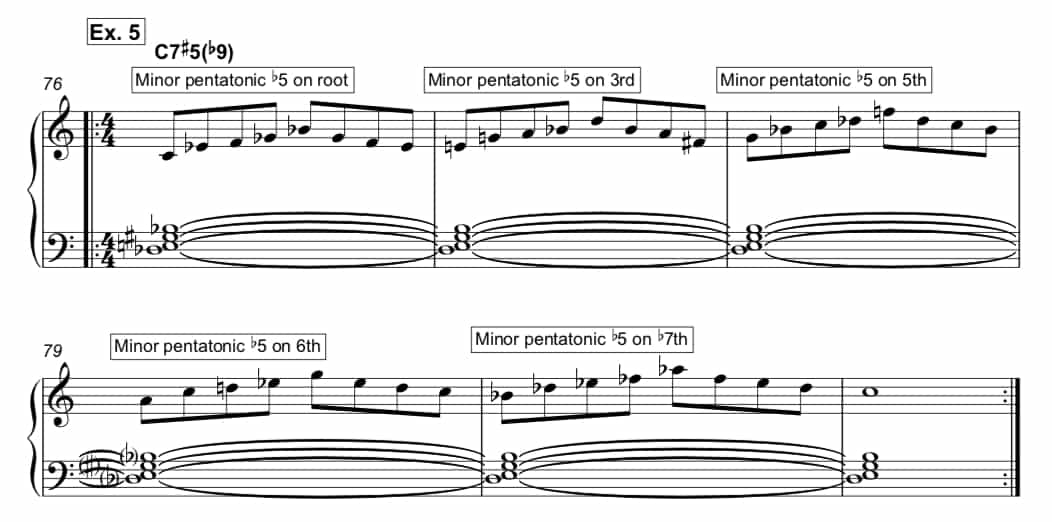Blues Piano Scales: Important Blues Essentials
 Would you like to learn how to play blues piano scales?
Would you like to learn how to play blues piano scales?
This is the lesson for you.
While you can learn the basics here, you’re also going to go beyond that and learn practical techniques.
Let’s get started.
Before We Begin This Blues Piano Scales Lesson…
 Knowing the major scale is a prerequisite to understanding this lesson. This is because we’ll talk a lot about scale degrees here.
Knowing the major scale is a prerequisite to understanding this lesson. This is because we’ll talk a lot about scale degrees here.
A major scale has 7 notes, the intervals of which starting from the root (in whole steps and half steps) are W-W-h-W-W-W-h.
In the key of C, the notes therefore are C, D, E, F, G, A and B before they repeat themselves over.
All of these major scale notes are also named in numerical scale degrees 1, 2, 3, 4, 5, 6, and 7.
You also need to understand accidentals. A sharp (#) raise a scale degree a half step up while a flat (b) lowers the scale degree a half step down.
In this lesson, we talk mostly about flats.
Get more details about these prerequisites right here at our how to read piano sheet music lesson.
Now let’s get right back into the meat of this tutorial.
Why Start With Minor Pentatonic Scale
 The first scale you’ll learn from this lesson is a 5-note scale called the minor pentatonic.
The first scale you’ll learn from this lesson is a 5-note scale called the minor pentatonic.
This is the most important scale shape you’ll learn because this will serve as a basic building block.
We’ll call the minor pentatonic as pentatonic shape 1.
Let’s look at the scale itself.
In the key of A minor, we have the notes A, C, D, E, and G.
Over the keyboard, you can play all of these notes using all your 5 fingers like this:

Take note that the formula for this scale is 1 – b3 – 4 – 5 – b7
By using this formula, you can learn how to play the minor pentatonic scale in all keys.
Let’s take a look at how to properly apply a minor pentatonic scale when soloing over chord changes.
How To Use The Minor Pentatonic Scale Over Chords
 Normally, in most songs, we can automatically use pentatonic shape 1 over the matching chord. For example, we use the A minor pentatonic over any Am chord.
Normally, in most songs, we can automatically use pentatonic shape 1 over the matching chord. For example, we use the A minor pentatonic over any Am chord.
This is rather obvious. However, there’s so much more to discover.
Let’s start with major chords.
If, for example, you’re playing over any C major chords (take note: this does not include dominant 7th chords), you can use any minor pentatonic scale formed over the 3rd, the 6th, and 7th.

For minor chords, play your minor pentatonic pattern over the root, 2nd, and 5th.

When talking about dominant 7th and minor 7th(b5) chords, we’re going to make use of another kind of pentatonic pattern. Read further.
How To Create Blues Piano Scales From The Minor Pentatonic
 To create blues piano scales from the minor pentatonic, we can do one of two things:
To create blues piano scales from the minor pentatonic, we can do one of two things:
- Add a flat 5th (b5) to the minor pentatonic.
- Replace the perfect 5th with a b5.
The b5 is what we call the “blue” note. The blue note is what creates that bluesy vibe for your scales and licks.
Now that you know what a blue note is, you can now easily into your minor pentatonic shapes.
However, you can do even more to really play blues piano scales.
Remember that we skipped how to use scales over dominant chords earlier? This time, we can now use this particular scale shape for dominant chords:

This is simply a minor pentatonic pattern with a b5 replacing the perfect 5th:
1 – b3 – 4 – b5 – b6
We’ll call this blues piano scale pentatonic shape 2.
For dominant 7th chords, use this pattern over the root, 3rd, 5th, 6th, and b7. For example, you can use these minor pentatonic b5 patterns over a C7 chord:

C – Eb – F – Gb – Bb
E – G – A – Bb – D
G – Bb – C – Db – F
A – C – D – Eb – G
Bb – Db – Eb – Fb (E) – Ab
When playing over minor 7(b5) chords, use pentatonic shape 2 on the root and pentatonic shape 1 on the minor 3rd, perfect 4th, and b7.
For example, for a Cm7(b5), use pentatonic shape 2 over the root (C-Eb-F-Gb-Bb) and pentatonic shape 1 over the minor 3rd (Eb-Gb-Ab-Bb-Db)˘, perfect 4th (F-Ab-Bb-C-Eb), and b7 (Bb-Db-Eb-F-Ab).

What We Have So Far
 To form our blues piano scales, we had two pentatonic shapes:
To form our blues piano scales, we had two pentatonic shapes:
- Pentatonic shape 1: 1-b3-4-5-b7
- Pentatonic shape 2: 1-b3-4-b5-b7
To use these shapes to solo over any song, here are the formulas:
- Major chords – Use pentatonic shape 1 over the 3rd, 6th, and 7th.
- Minor chords – Pentatonic shape 1 over the root, 2nd, and 5th
- Dominant chords – Pentatonic shape 2 over the root, 3rd, 5th, 6th, and b7.
- Minor 7th(b5) chords – Pentatonic shape 2 over the root, pentatonic shape 1 over b3, 4, and b7.
Let’s look at some of the best ways to practice these blues piano scales.
How To Practice Blues Piano Scales
Here’s the first way to practice these blues piano scales:
Practice the pentatonic shapes as 5-note block chords. This is the most important practice method.

 By practicing the right pentatonic shapes over matching chord types, you train your fingers to pursue those notes over those chords.
By practicing the right pentatonic shapes over matching chord types, you train your fingers to pursue those notes over those chords.
Once you get a hang of playing those shapes, you only need to deconstruct those shapes when playing melodies or harmonies.
 Get used to playing those shapes by practicing them in all 12 keys over all basic chord types.
Get used to playing those shapes by practicing them in all 12 keys over all basic chord types.
Once you are comfortable with the block chord shapes, play the shapes one note at a time. Do this ascending and descending over a couple of octaves.
After some time, practice coming up with some note sequences using the notes of the scales.
Once you have those scale shapes burned into muscle memory, spend most of the time practicing musically.
When we say “musical” practice, this involves trying to develop musical ideas using the scales. For example, play a 12-bar blues while messing around with these blues piano scales.
Another kind of musical practice is improvising lines with these pentatonic shapes over songs.
Start incorporating these pentatonic shapes into your solos to solidify them into your musical vocabulary.
How To Use The Blue Note With Blues Piano Scales
With both pentatonic shapes we have seen, we can always incorporate the blue note.
Because the blue note is technically a diminished 5th (which sounds dissonant), we usually resolve it down or up a half step in solos and melodies.
Incorporating The Blue Note In Pentatonic Shape 1
 For chords where you have to use pentatonic shape 1, you can incorporate the blue note as well.
For chords where you have to use pentatonic shape 1, you can incorporate the blue note as well.
Use the blue note as an ornament resolving up a half step to the perfect 5th.
This Otis Spann Lick is a great example of this idea:

Using The Blue Note For Pentatonic Shape 2
 In pentatonic shape 2, it’s already given that you have a blue note (b5).
In pentatonic shape 2, it’s already given that you have a blue note (b5).
In chords where you can use pentatonic shape 2 (dominant and minor 7b5 chords), you resolve the blue note a half step down.
For example, let’s take this blues lick from David Paich’s piano solo in the Toto hit “Rosanna”:

The entire lick makes use of pentatonic shape 2 on the root and the 6th of the G7 chord.
Interestingly, all you have to do to play the lick is break up the shapes.
Wrapping Up
I hope that you enjoyed this different take regarding how to play blues piano scales.
If you have any questions, comments, or suggestions for a new lesson, feel free to leave a note below.
Have fun practicing.

Hi Mark
Love the info youre imparting here but alas the important parts of your lessons Ex 11 and 12 are of no use to me and probably many others who cannot read notation.
Maybe you could consider an audio track or video for future lessons to allow for non readers.
Many thanks
Tom
ps. Be great if you could send me the note names as mentioned above.
Thanks